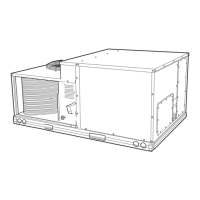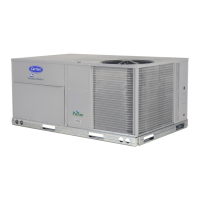Do you have a question about the Carrier 48TJD Series and is the answer not in the manual?
Instructions for supporting the unit, including roof curb and slab mount options.
Guidelines for fabricating and securing external ductwork for vertical and horizontal units.
Procedures for installing an external trap for the unit's condensate drain connection.
Instructions on safely rigging, moving, and positioning the unit on its final support.
Details on installing the flue hood and screen for proper exhaust ventilation.
Guidance on installing gas piping, including codes and connection sizes.
Procedures for making electrical connections, including disconnect box and field wiring.
Steps for adjusting outdoor air dampers and installing the outdoor air hood.
Instructions on how to adjust the evaporator fan speed to meet specific conditions.
Pre-start-up checks including filter installation, compressor mounting, and wiring.
Procedures for starting the unit in cooling mode and checking refrigerant charge.
Steps for starting the unit in heating mode and verifying burner ignition.
Instructions for cleaning evaporator and condenser coils, filters, and outdoor-air inlet screens.
Information on lubrication requirements for compressors and fan motor bearings.
Procedures for checking and adjusting the refrigerant charge using charging charts.
Table detailing LED error codes, their causes, and remedies for IGC faults.
Troubleshooting guide for heating issues like igniting, inadequate heating, and poor flame.
Troubleshooting guide for cooling issues like compressor not starting or excessive pressures.
Instructions for supporting the unit, including roof curb and slab mount options.
Guidelines for fabricating and securing external ductwork for vertical and horizontal units.
Procedures for installing an external trap for the unit's condensate drain connection.
Instructions on safely rigging, moving, and positioning the unit on its final support.
Details on installing the flue hood and screen for proper exhaust ventilation.
Guidance on installing gas piping, including codes and connection sizes.
Procedures for making electrical connections, including disconnect box and field wiring.
Steps for adjusting outdoor air dampers and installing the outdoor air hood.
Instructions on how to adjust the evaporator fan speed to meet specific conditions.
Pre-start-up checks including filter installation, compressor mounting, and wiring.
Procedures for starting the unit in cooling mode and checking refrigerant charge.
Steps for starting the unit in heating mode and verifying burner ignition.
Instructions for cleaning evaporator and condenser coils, filters, and outdoor-air inlet screens.
Information on lubrication requirements for compressors and fan motor bearings.
Procedures for checking and adjusting the refrigerant charge using charging charts.
Table detailing LED error codes, their causes, and remedies for IGC faults.
Troubleshooting guide for heating issues like igniting, inadequate heating, and poor flame.
Troubleshooting guide for cooling issues like compressor not starting or excessive pressures.
| Brand | Carrier |
|---|---|
| Model | 48TJD Series |
| Category | Air Conditioner |
| Language | English |












